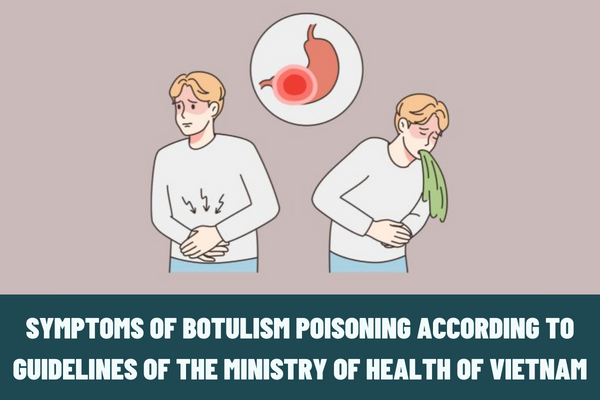What are the symptoms of Botulism poisoning according to the guidelines of the Ministry of Health of Vietnam? What Botulinum antitoxins are used for adults and children?
What are the symptoms of Botulism poisoning?
Pursuant to Decision No. 3875/QD-BYT in 2020 on provisional interim guidelines for diagnosis and treatment of Botulism poisoning issued by the Ministry of Health of Vietnam.
Botulism poisoning is understood as foodborne botulism caused by ingestion of food contaminated with the botulinum toxins (canned meat, foods processed, packaged food not ensuring food safety, etc.)
Symptoms of clinical Botulism poisoning are defined in Clause d, Subsection 3.1, Section 3 of the Guidelines issued together with Decision No. 3875/QD-BYT in 2020 as follows:
(1) Vital signs: no fever (unless due to other causes), blood pressure might drop while heart rate tends to not increase.
(2) Gastrointestinal symptoms: nausea, vomiting, abdominal distension and/or stomach cramps develop early, before paralytic ileus, constipation.
(3) Neurological symptoms:
- Symmetric paralysis, starting from the head and neck to the legs: from the cranial nerves (ptosis, diplopia, blurred vision, throat pain, speaking difficulty, swallowing difficulty, hoarse voice, dry mouth), And then arm paralysis, paralysis of chest and abdominal muscles and leg paralysis.
- Decrease in or loss of stretch reflexes.
- Lucidity.
- Possible dilation of both pupils.
- No sensory disturbances.
- Paralysis level: from mild (fatigue, muscle fatigue similar to asthenia, inability to perform normal effortful tasks) to severe (sputum build-up, haemoptysis, easily choking, respiratory failure). The patient may develop paralysis of all muscles and dilation of both pupils and require breathing support, which can be mistaken for coma or vegetative state (the patient is actually awake unless there is lack of oxygen to the brain).
- Average duration of mechanical ventilation prior to ventilator withdrawal is 2 months for patients poisoned with type A toxin and 1 month for those with type B toxin. However, patients might need up to 100 days before they start recovering.
- Atypical picture (accounting for 7%): hemiparesis or ascending paralysis.
(4) Respiratory symptoms: possible respiratory failure, sputum build-up, haemoptysis, breathing difficulty, rapid shallow breathing due to paralysis of the intercostal muscles, diaphragm.
(5) Urology symptoms: urinary retention, distended bladder
What are the symptoms of Botulism poisoning according to the guidelines of the Ministry of Health of Vietnam? What Botulinum antitoxins are used for adults and children?
When will symptoms of poisoning appear after eating?
Pursuant to Clause c, subsection 3.1, Section 3 of the Guidelines promulgated together with Decision No. 3875/QD-BYT in 2020, the time of onset is determined as follows:
- 12-36 hours after food consumption, mostly in the first day;
- Approximately 6 hours to 8 days after food consumption
What Botulinum antitoxins are used for adults and children?
Pursuant to Clause 4.2.4, sub-section 4.2, Section 4.2 of the Guidelines promulgated together with Decision No. 3875/QD-BYT in 2020 of the Ministry of Health of Vietnam, there are regulations on the Botulinum antitoxins as follows:
Antitoxins
- Botulinum antitoxin is comprised of antibody/neutralizing antibody fragments capable of neutralizing the botulinum toxin. The antitoxin must contain all antibodies/neutralizing antibodies against each toxin component that is poisonous to humans. In theory, the antitoxin is only effective against free toxins and not toxins bound to nerves, thus, it cannot immediately reverse paralysis. However, the antitoxin can prevent the poisoning from worsening and shorten the poisoning duration, ventilation duration, recovery time and hospitalization time significantly.
- The antitoxin is an orphan drug and its preparations are available in limited quantity under orphan drug programs of other countries. One preparation frequently mentioned in recent documents and currently prioritized is Botulism Antitoxin Heptavalent (made from horses, containing F(ab')2 antibody fragments effective against botulinum toxins of types A, B, C, D, E, F, and G).
Thus, the current Botulinum antitoxin is Botulism Antitoxin Heptavalent (made from horses, containing F(ab')2 antibody fragments effective against botulinum toxins of types A, B, C, D, E, F, and G).
The antitoxin can prevent the poisoning from worsening and shorten the poisoning duration, ventilation duration, recovery time and hospitalization time significantly.
How many ways to perform a Botulinum detoxification?
Pursuant to subsection 4.2, Section 4 of the Guidelines promulgated together with Decision No. 3875/QD-BYT in 2020, after receiving the patient, perform Botulinum detoxification for patients in two ways:
- Induce vomiting: if the patient has just consumed the food causing suspicion.
- Administer activated charcoal: most patients arrive at the hospital late, however, activated charcoal is recommended as the toxins as well as the bacteria can survive in the gastrointestinal tract for many hours to many days later. Administer a dose of 1g/kg in combination with a dose of sorbitol equivalent to that of activated charcoal used.
LawNet